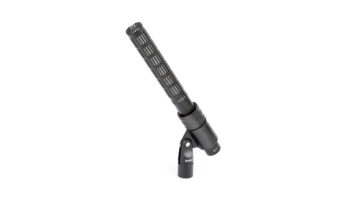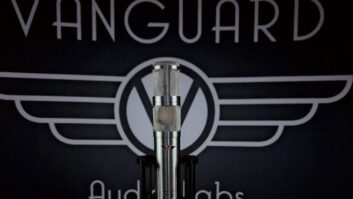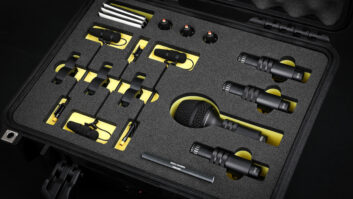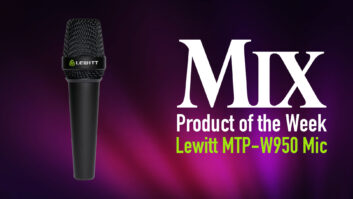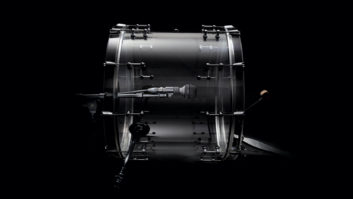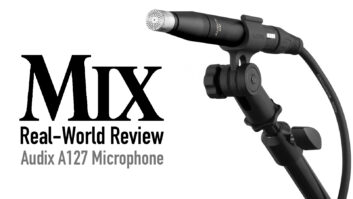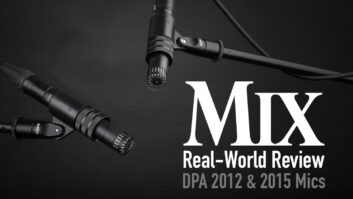DPA is a major player in the small-capsule mic market. The company’s 4060 and 4061 miniature mics are ubiquitous in broadcast, Broadway and beyond. The Holophone H2 (reviewed in Mix, March 2005) uses eight DPA 4060 capsules and was recently brought in to record the surround feed at the 2006 Grammy Awards. Fox Sports mixer Fred Aldous uses four H2s to capture the realism of NASCAR for broadcast.
The latest miniature capsule mic from DPA is the handsome and light 4090 Series. The 4090 and 4091 differ only in their sensitivity, and both are omnidirectional and phantom-powered. As with DPA’s other small-capsule mics, a “0” at the end denotes high sensitivity and a “1” means low sensitivity; in other models, a “2” flags the mic as exhibiting extra-low sensitivity. For this review, I used two 4091s.
The 4091’s tapered body is a mere 4.75 inches long with the pre-polarized condenser capsule measuring 5.4 mm in diameter. The mic’s low profile and focused front end allowed me to place it ever so precisely in a number of situations. I’ve used other small-capsule mics, but none this short. Because of its small footprint, it was a breeze to squeeze the mic in under cymbals for recording toms or to microscopically place it in front of an acoustic guitar, picking the perfect spot with absolute accuracy.
And now for the stats. The 4091 has an S/N ratio of 68 dBA, a dynamic range of 97 dB and will take a whopping 144dB SPL. Its polar chart shows the mic’s off-axis response is very flat out to 20 kHz. Omnis are not usually that “omni” above 1 kHz because of the wavelength. Having this kind of response at the back of the mic, with 5 kHz and 10 kHz nearly identical, is remarkable.
TINY MIC, BIG SOUND
I used the 4091s to record drums on a variety of sessions, trying them first on toms. Because of its lack of directionality, an omni is not often the first choice for this application. However, a lot of sonic info under the cymbals is lost when using cardioids that can be reclaimed by using an omni. I was pleasantly surprised by the 4091s. They took plenty of SPL and were easy to focus and place without getting in the way of the swaying cymbals, which, in this case, were slung low and just above the toms.
The mics excelled in use as stereo overheads and as room mics. Due to their low sensitivity, the mics tend to concentrate on what’s closest to them, which makes them sound less “omni” as overheads than you’d think. I was able to get more of the kit into the spotlight by simply lowering the mics closer to the cymbals. Placing the 4091s 1.5 feet above the tops of the cymbals was perfect for this kit and room, which had a concrete floor, well-damped walls and 18-foot ceilings with clouds hanging three feet below the corrugated metal ceilings.
I appreciated the 4091s’ off-axis linearity when using them as room mics. A spaced pair sounded very good about nine feet in front of the kit and seven feet off the floor. This placement offered a nice picture of the kit within the room that easily blended into the mix. Transients were no problem for the 4091s; the cymbals weren’t brash and didn’t smear when they were hit hard. The stereo picture was full and precise.
When used in a drum booth placed behind the drummer and fired up into the back corners of the room, hugging the wall about eight feet up, the mics exhibited a lot of thump and low end that I dug out further with a compressor. I then used this as a trashy room feed that took the kit to a place where the regular mics didn’t go.
The 4091s were made for recording acoustic guitar. Placed as a spaced pair in front of the instrument, the mics exhibited an even sound from top to bottom — just enough boom and not too bright with plenty of middle, as if you were standing in front of the player. Once again, the stereo picture was excellent.
I also used a 4091 to record a Venezuelan cuatro. It’s a short-necked, small-bodied instrument with the low strings at the top and bottom and the higher-pitched strings in the middle (tuned A, D, F#, B), enabling the player to get a similar sound whether strumming up or down. The instrument can really cut through a track and doesn’t have a lot of low end. I placed a single 4091 at just above the soundhole where the neck meets the body and ran the signal through a Neve 5012 Portico preamp, which represented it beautifully, making this signature instrument a joy to listen to, even though it has a tendency to be out front and in your face.
Next, I placed the pair of 4091s on a Leslie (145 cabinet with a 122 amp). I spaced the pair across the corners of the upper cabinet to get the full Doppler effect. The mics captured the signature nasty Leslie grind, and when mixed with a single U87 that I placed at the bottom of the cabinet to cover the low end, the 4091s made the whole rig sound as big as a house. They also worked extremely well as a spaced pair just over the strings of an acoustic piano, handling all the level associated with such a close placement, and offering up all the bottom and top of the instrument without ever sounding boomy or strident. Omnis are great in this application in that you can get in as close as you want without ever worrying about proximity effect.
Last, I used the 4091/Portico 5012 combination to record both soprano and tenor saxophones. It worked well in both situations. For the tenor, I placed the mic just above the bell facing directly and horizontally back at the player toward the keys, about a foot in front. For the tenor, however, I opted for a mic with a bit more character and coloration to flesh out the bottom end a bit more. But for the soprano, the 4091 worked very well, offering up all the high end the instrument had to offer without being too shrill. It was placed about halfway along the horn, aiming at the keys, about a foot from the instrument. Once again, the tame and accurate nature of the 4091’s upper response made for a happy ending to this recording story.
REALISM DEFINED
The 4091 lets you experiment with placement like no other mic I’ve used. It’s small from front to back, and its pointed end makes it easy to position it precisely there, and if that isn’t right, just a little bit to the left or right of there — and I do mean just a little bit. This was critical in the acoustic guitar recordings. The first time I heard the mic, it was flying solo and lacked depth. But that was due to its placement and not the mic’s fault. Once adjusted, it flowered into full realism, accurately depicting the guitar in the track.
The mic is also very lightweight, so scooting it just a bit up or down is effortless. Its lightness and size makes you want to experiment with placement, which is the engineer’s best friend. Larger mics, especially side-address units, do not engender that kind of enthusiasm.
As far as how the 4091 sounds, I like to call it the story of Goldilocks and the three mics. It’s not too tubby nor does it have an excessively bright top; it’s just right. However, this mic will offer up some low end in spades if properly placed. For instance, used as a pair of room mics on drums, it rocked the house with plenty of LF from the kick drum as the waveform had a chance to develop and fill the room. As a pair, the mics exhibited bountiful bottom when placed in the corners of a medium-sized drum booth, taking advantage of the boundary effect at the wall behind the drums.
The DPA 4091 is a great-sounding, versatile, easy-to-place mic that can take plenty of SPL and provides an accurate picture in a variety of sonic situations. And the best part? At $600 each, you can get a pair of these for a song.
DPA Microphones, 866/DPA-MICS, www.dpamicrophones.com.
Kevin Becka is Mix’s technical editor.

